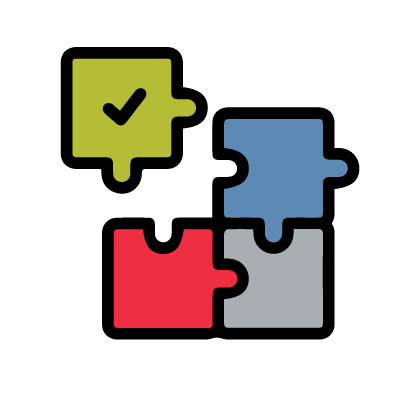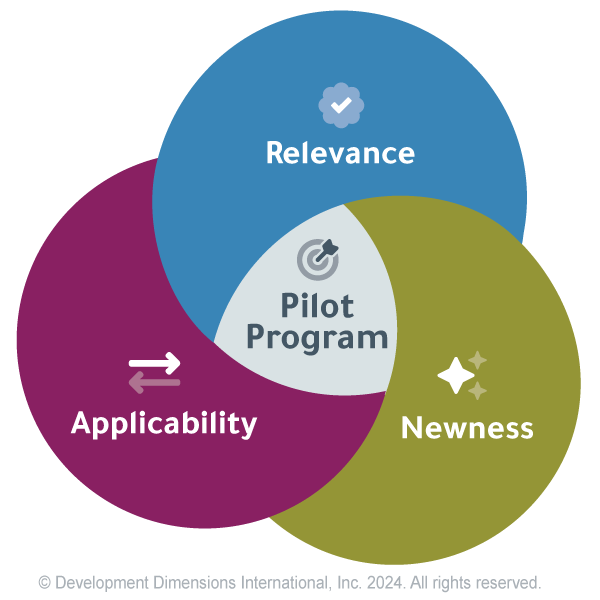Let’s picture two companies, each looking to build a leadership development pilot program. Company A wants to launch an award-winning program, spending months meticulously planning, debating various options, and seeking input from numerous stakeholders. Company B also wants to go large with its program and demands an equally high level of quality for its participants. Their approach, however, differs.
Company B makes a bold move, launching swiftly, trying out different approaches with small cohorts of leaders, and learning from each step. What they learn in the process helps them iterate and drive toward an optimized program faster than trying to get it "right the first time." Ultimately, they reach more leaders quicker and more effectively than Company A.
Sure, Company A will eventually reach leaders. But they’re banking on their model working perfectly on the first try without testing it in a safe environment. (Hint: It likely won’t.) This adds up to more time to fix what isn’t working. However, the program was initially intended to help leaders quickly learn core elements of their roles. So, more time isn't exactly the best approach.
By the time Company A finally delivers to the first cohort, the expectation level has risen to the extent that even perfection will not do. The participants and observers are hypercritical, and the poor L&D team has a heap of rework to do. They suspend the program while they rework it, pushing progress even further back. Meanwhile, Company B merrily soldiers on, delivering, evaluating, and improving its program, reaching 500+ learners before Company A has even hit 50.
Either of those scenarios sound familiar?
A worthy reflection point is considering what your business is asking for and why. Many of us have heard the phrase, "We need to invest in our leaders.” But how many senior executives in a business are really saying, “We need to have the perfect leadership development program"? Ultimately, your senior executives are accountable to investors for delivering business results. So, what they’re requesting are the different behaviors that will drive those results. And they’re likely to want them quickly.
Ahead, we’ll explore how to build a successful pilot program to accelerate your organization's development efforts, including tips for evaluating your program throughout the process to maximize results.
What Is a Leadership Development Pilot Program?
First, let’s address exactly what a pilot program is. In the context of leadership development, a pilot program is a small-scale model, a concept based on where we are (current reality) vs. where we want to go (desired future state). The pilot program aims to be the best representation of what it will take to deliver the desired future state. As such, when implementing the pilot, you’re looking to learn quickly, test, and refine your approach to leadership development before fully scaling up.
What Is the Aim of a Pilot Program?
Let’s be clear: The aim of a pilot program is not to create perfection. That goal is not worth striving for, as we’re never going to please every stakeholder in the business. And as many of you know, your stakeholders have opinions and preferences that they want to prioritize.
A pilot program should focus on the core competencies that will help leaders deliver on the organization’s strategic and cultural priorities—and that’s never going to be achieved by inviting all stakeholders to share their views. That’s a recipe for creating something too large for the business to fund and overwhelming for your learners. At the end of the day, you’re looking to upskill and drive behavior change in a leadership population.
So, when creating your pilot, start with the critical competencies that fuel business goals, leverage content that drives behavior change, and work out what you’re going to measure. A wise colleague once told me that perfection is the enemy of progress. So, get yourself and your colleagues into "discovery mode" and launch quickly. Your business needs better leaders now, not a year down the line.
The aim of a pilot program is not to create perfection; that goal is not worth striving for, as we’re never going to please every stakeholder in the business.
Advantages of a Leadership Development Pilot Program
Because goals for a pilot program will vary, companies will experience various benefits from the approach. Here are a few reasons pilots can give you an advantage:
- Pilots are flexible and adaptable. Pilots offer the flexibility to adjust as you learn from your experiences. You can tailor the program to meet the specific needs of your leaders and the organization.
- Pilots use a growth-centered approach. When piloting, you and everyone else are in growth mode, looking for what you can measure and improve rather than achieving perfection. This mindset allows you and those around you to experiment and innovate, leading to better results.
- Pilots help you spot gaps fast. When you put your program in front of leaders who are desperate to improve, you’re sure to get quick feedback on the skills they struggle with most. This allows you to address the gaps promptly and enhance leadership effectiveness. It certainly beats chasing responses to the needs analysis survey currently sitting at the bottom of everyone’s inbox, too.
- Pilots are dynamic. When you haven’t spent your entire budget on upfront design, it’s much easier to fund and implement the adjustments you want to see. This results in a better-aligned, more cost-effective program that delivers value from day one.
Remember—piloting is not about getting everything right the first time. Learning isn’t a one-time event; it’s a process. Too often, organizations approach pilots with lengthy timelines and overwhelming expectations that simply lead to failure as they overthink and overdesign the program. Instead, a fast-pilot approach prioritizes speed and focuses on the most critical elements that will drive business success.
How Do You Build a Leadership Development Pilot Program?
Now for the fun part—building a pilot program. Follow these steps to find success:

1. Set Goals
A pilot program’s primary objective should be to deliver the most critical skills to your leaders as quickly as possible. So, you must be precise about your targets. Again, don't strive for perfection here; aim for the most significant impact in the shortest time.
Start by asking yourself: What do we need leaders at this level to do in order to hit strategic goals? Identify three to four things leaders need right now that will deliver 80% of that success. Identify the behaviors you want to see more of and train people on those core competencies. Your measure of success is simple—are you seeing more of those behaviors after the training than you saw before?
Some other questions you’ll want to ask yourself:
- Which leaders need development most urgently?
- How should I communicate the goals to stakeholders?
- What other measurements will tell us the pilot is working, and how will I collect the data?
When you begin your program with clear questions and objectives, you set the groundwork for a structured approach. Ultimately, this helps you effectively assess what works and what doesn't. A successful pilot program should focus on improving the organization's understanding of its needs and how to meet them effectively.

2. Design a Fit-for-Purpose Program
When you build a pilot program, it’s essential to strike a balance between speed and completeness. There’s no point in testing out something that’s obviously deficient and doesn’t represent what you want to achieve, nor is there any sense in delaying, waiting for every bit of content to be ready to deploy. Consider these points to help you get started:
- Participant selection: Choose individuals who represent your target group. Avoid selecting only experienced leaders who may approach the program as observers rather than active participants. And whatever you do, please avoid the temptation to stack the pilot group full of HR experts. Remember, you’re not evaluating whether HR likes the models (everyone has their favorites, right? 😉) but whether the program delivers the behavior changes your business needs. You need to know if leaders are getting sufficient self-insight and practical guidance to make a difference in the workplace. And those leaders are the only ones who will be able to tell you.
- Program length and frequency: You’ve got to ask yourself what will work with people’s work rhythms. Are they already overloaded? Is a full day out of the office too much? Are you looking to drive other benefits, such as connecting a network and breaking down silos? If there is little recent development history in the organization, chances are it will work better to space modules out to give people time to practice what they’ve learned and embed one new skill before moving on to the next.
- Curriculum and content: Focus on the most critical skills leaders need to succeed. Deliver content that aligns with your organization's goals and context. Consider what you already have access to that will be effective. It can be tempting to try to build from the ground up. However, leveraging existing collateral or proven content from a trusted partner will get you quicker results, and more effectively.
Keep in mind: A well-designed pilot program strikes a balance between achieving quick wins and long-term growth. You’ll need to remind participants that, just like they’re striving to be better leaders, you’re also continuing to improve the program for the future, making their feedback crucial.

3. Learn and Adapt
You should be in full learning mode once your pilot program is off and running. You need to look out for and listen to all the information that will help you improve. Essentially, what is contributing most to the changes you want to see? What is enabling change, and what is getting in the way? That way, you can ensure you keep (and even amplify) the positive aspects while iterating or replacing the less effective parts. To do this, one of the simplest ways is to gather feedback from participants and stakeholders using surveys and assessments to evaluate:

- Relevance: Is the content pertinent to the participants' roles and challenges?
- Newness: Are participants learning new skills and concepts they haven't encountered before? There’s no sense doubling down on things your leaders already excel at. It is much better to spend the time adding new tools to the toolkit.
- Applicability: How easily can participants apply what they have learned in their day-to-day work? For some "harder to develop" competencies, you might notice that the participants understand the concepts but struggle to translate them into actionable behaviors at work. Where you see this, you can add in more skill practices, leverage digital simulations, or provide some bridging/application tools such as conversation planners. Alternatively, you might need to flex your facilitator debriefs to ensure they can link to the participants’ business context and turn abstract concepts into real-world insight.
This evaluation process allows you to reflect on the pilot’s successes and failures and is an essential step in improving the program's alignment with your organization’s goals.
Achieve More While Moving Faster
Before you begin, remember that the biggest mistake with a pilot program is viewing it as a tentative, temporary, or "lite" version of the program. Instead, help your organization view your pilot as a smart tactic to help you innovate, move faster, and achieve more. Ultimately, a well-executed pilot program will empower your organization to innovate, learn, and deliver value rapidly.
So, while you're shouting to the rooftops about your contribution to your organization's growth, spare a thought for your friends at Company A. They are still stuck in concept mode, desperately hoping to try their program out on some real learners—one day.
Ready to take the next step? Learn how to build a strong foundation for your leadership development program with our webinar, Starting Your Leadership Program: Build a Strong Foundation.
Topics covered in this blog

